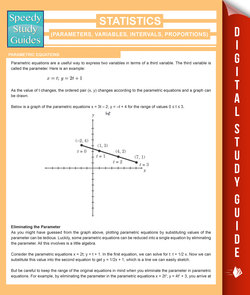Читать книгу Statistics (Parameters, Variables, Intervals, Proportions) (Speedy Study Guides) - Speedy Publishing - Страница 2
ОглавлениеSTATISTICS
(PARAMETERS, VARIABLES, INTERVALS, PROPORTIONS)
PARAMETRIC EQUATIONS
Parametric equations are a useful way to express two variables in terms of a third variable. The third variable is called the parameter. Here is an example:
As the value of t changes, the ordered pair (x, y) changes according to the parametric equations and a graph can be drawn.
Below is a graph of the parametric equations x = 3t − 2; y = −t + 4 for the range of values 0 ≤ t ≤ 3.
Eliminating the Parameter
As you might have guessed from the graph above, plotting parametric equations by substituting values of the parameter can be tedious. Luckily, some parametric equations can be reduced into a single equation by eliminating the parameter. All this involves is a little algebra.
Consider the parametric equations x = 2t; y = t + 1. In the first equation, we can solve for t: t = 1/2 x. Now we can substitute this value into the second equation to get y = 1/2x + 1, which is a line we can easily sketch.
But be careful to keep the range of the original equations in mind when you eliminate the parameter in parametric equations. For example, by eliminating the parameter in the parametric equations x = 2t2; y = 4t2 + 3, you arrive at
